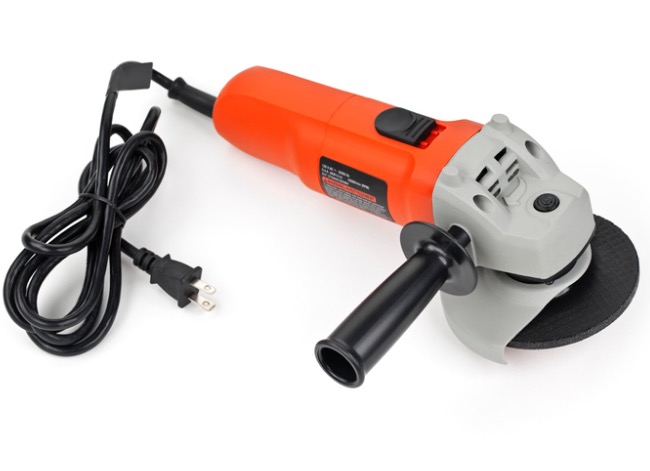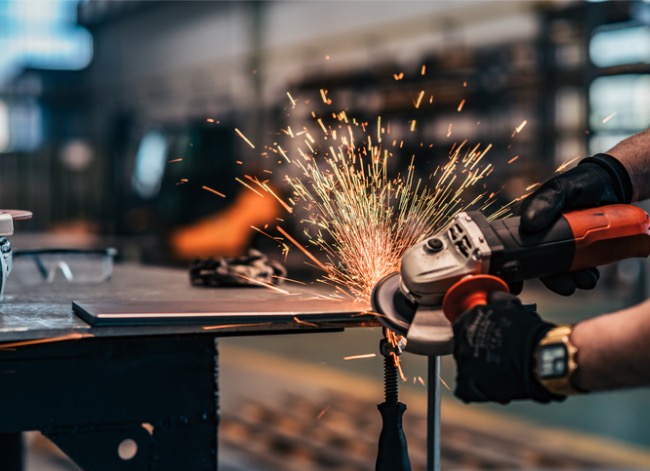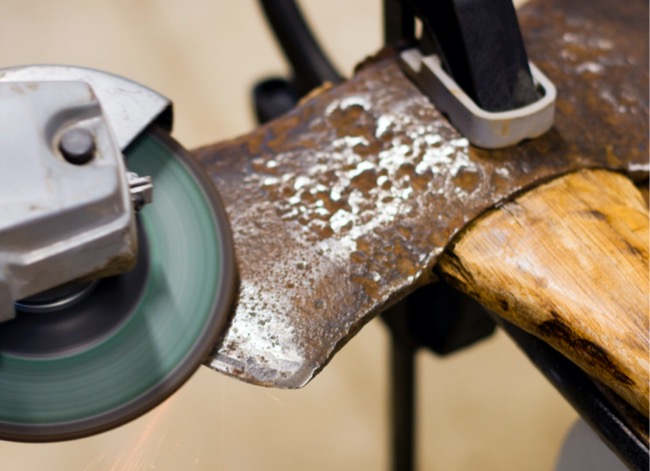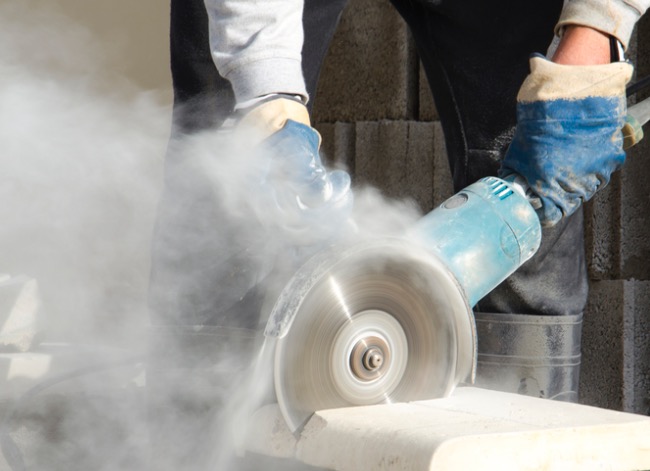

We may earn revenue from the products available on this page and participate in affiliate programs. Learn More ›
Angle grinders are a versatile power tool with a rapidly rotating disc that cuts, grinds, polishes, sharpens, and cleans a wide variety of difficult materials, including iron, copper, brass, brick, tile, stone, or mortar. The tool rotates the discs with a high amount of torque and an average operating speed of about 12,000 revolutions per minute (rpm), and some have variable speeds that can operate as low as 2,800 rpm. By changing the speed and the disc, you can alternate between grinding through metal and polishing metal, so it’s important to make sure the angle grinder is appropriately equipped for each project’s goal before starting.
These tools can operate on a battery or they can be directly connected through a power cord to provide a constant supply of electricity to the motor. Cordless grinders are a great option for short projects or specific cutting or grinding tasks. If you need to use the grinder for more than an hour, it may be better to invest in a corded angle grinder. Whichever type is chosen, users should always make sure they are wearing appropriate personal protective equipment (PPE) including a mask, safety glasses, work gloves, and earplugs.
1. Grinding and Polishing Metal
The primary purpose of an angle grinder is to grind metal. It achieves this with the use of abrasive grinding discs that come in a range of materials, like aluminum, carbide, and diamond-tipped discs. Attach a grinding disc and turn on the grinder to start the disc spinning rapidly. Press the abrasive disc to the target metal to flatten, smooth, or completely remove pieces from the metal.
At a lower speed setting, a smoothing or polishing wheel can improve the finish of the metal and enhance the color. Smoothing involves removing a fine layer from the metal to leaving a clean finish behind. Polishing wheels are made of soft materials, like cotton, and they actually add a layer of polish to get a mirror-like finish on smooth metal surfaces. If the speed isn’t adjustable, then a smoothing or polishing wheel may remove too much of the surface. Also, keep in mind that both smoothing and polishing take more time and patience than grinding.

2. Cutting Metal
The rapidly rotating disc on an angle grinder doesn’t just smooth, polish, and grind away metal, it can also be used for cutting through metal. This is a common use for plumbers who are working with galvanized iron or lead pipes. Welders frequently cut pieces of metal to clean up projects or prepare a piece of metal to serve as a match.
Change out the abrasive grinding disc for a cut-off disc. Cut-off discs come in different thicknesses, but they are thinner than grinding discs. The thin size makes it easier for the spinning disc to cut through metal because it needs to remove less material than if you were using a thicker grinding disc. However, the thin size also means that cutting discs are more vulnerable to bending and breaking. Avoid breaking the cut-off disc by allowing the grinder to cut through the metal at a moderate pace instead of trying to force it through at a faster speed.
RELATED: 6 Things to Know Before Cutting Metal
3. Cleaning Metal
Remove paint, rust, and lacquer from metal surfaces with the help of an angle grinder. Equip a plastic stripping disc or a metal cleaning wheel to take off chipped and peeling layers without damaging the metal underneath. Plastic stripping discs are a good option for removing paint, lacquer, and similar coatings that aren’t fused to the metal. These discs are made with nylon webbed material and silicon carbide to provide enough abrasion to lift these coatings away from the metal.
If you need to take off rust, then a metal cleaning wheel is a better choice. Metal cleaning wheels are made with a series of metal wires twisted through each other to create an effective rust-removal wheel. When this wheel is rapidly spinning and it comes in contact with the metal surface, it scrapes away surface rust to expose the clean metal. These wheels can sometimes shoot small pieces of broken wire, so always wear appropriate PPE.
4. Sharpening Tools
Angle grinders also can be used to sharpen other tools, like restoring the edge to lawn mower blades, axes, or chisels. Equip the angle grinder with an abrasive grinding disc and ensure that the blade of the tool is properly secured in a vise so that you can focus on controlling and steadying the movement of the grinder.
When sharpening tools with a grinder, it’s important to orient the grinding disc with the angle on the blade so that the sharpened blade has the same angled cut. Altering the cutting angle can significantly reduce the effectiveness of the tool and may actually ruin the blade. A grinder is good for quickly sharpening your tools, but consider using a sharpening stone afterward to add a more precise edge to the blade before putting the tools away.

5. Cutting Tile, Stone, Other Masonry Materials
While angle grinders are primarily used when working with copper, iron, steel, lead, and other metals, they also can be used to cut through tough masonry materials, including tile, stone, and brick. Switch out the metal cut-off disc for a masonry cutting wheel and cut straight through these difficult materials. The precision of an angle grinder makes it useful for cutting custom angles in tile to help with bathroom shower repairs, making a garden pathway from brick or stone, or replacing broken pieces of a backyard fire pit.
These cutting wheels are made to withstand a significant amount of strain, so they aren’t as fragile as metal cutting discs. However, they are still susceptible to chipping or breaking when the grinder is forced through the material. The risk of chipping and breaking increases with older used cutting wheels, so be sure to regularly replace the masonry cutting wheel for smooth clean cuts.
RELATED: How To: Cut Concrete

6. Removing Mortar
Leaks, drafts, and recurring insect infestations can be fixed by replacing the mortar on the exterior of a home. However, getting the mortar out without damaging the bricks isn’t easy without the use of an angle grinder. Get a thick abrasive grinding disc that can handle soft masonry work or use a masonry cutting wheel to begin chipping away at the lines of mortar between the bricks.
The narrow disc doesn’t have any issue fitting in these gaps and with careful control, most of the mortar can be completely removed without touching the brick. Then you just need to fill the mortar joints with new mortar to significantly reduce heat loss and potentially reduce your energy bills. Just be sure to have a face shield or safety glasses and other suitable PPE to keep yourself safe while you work.
